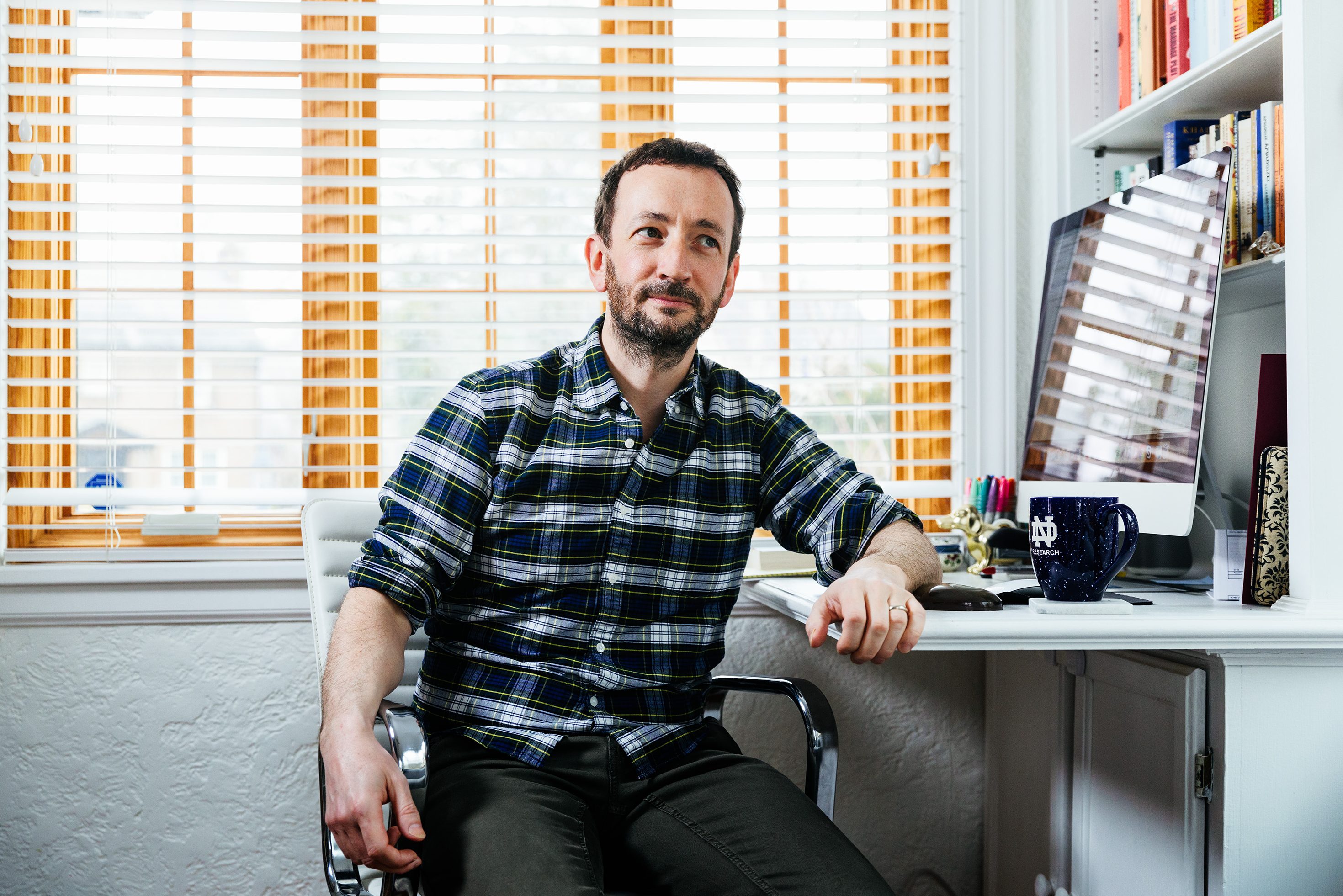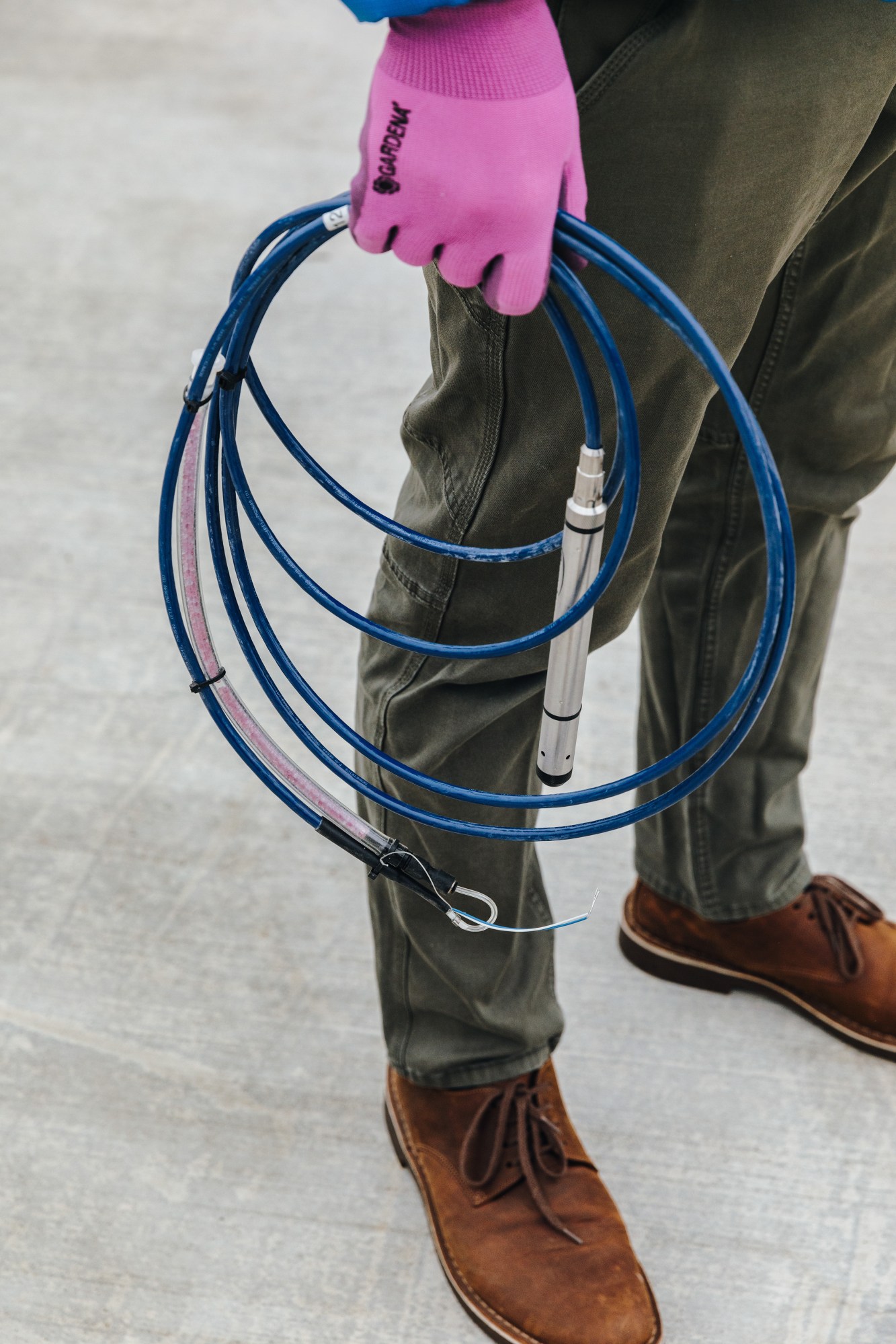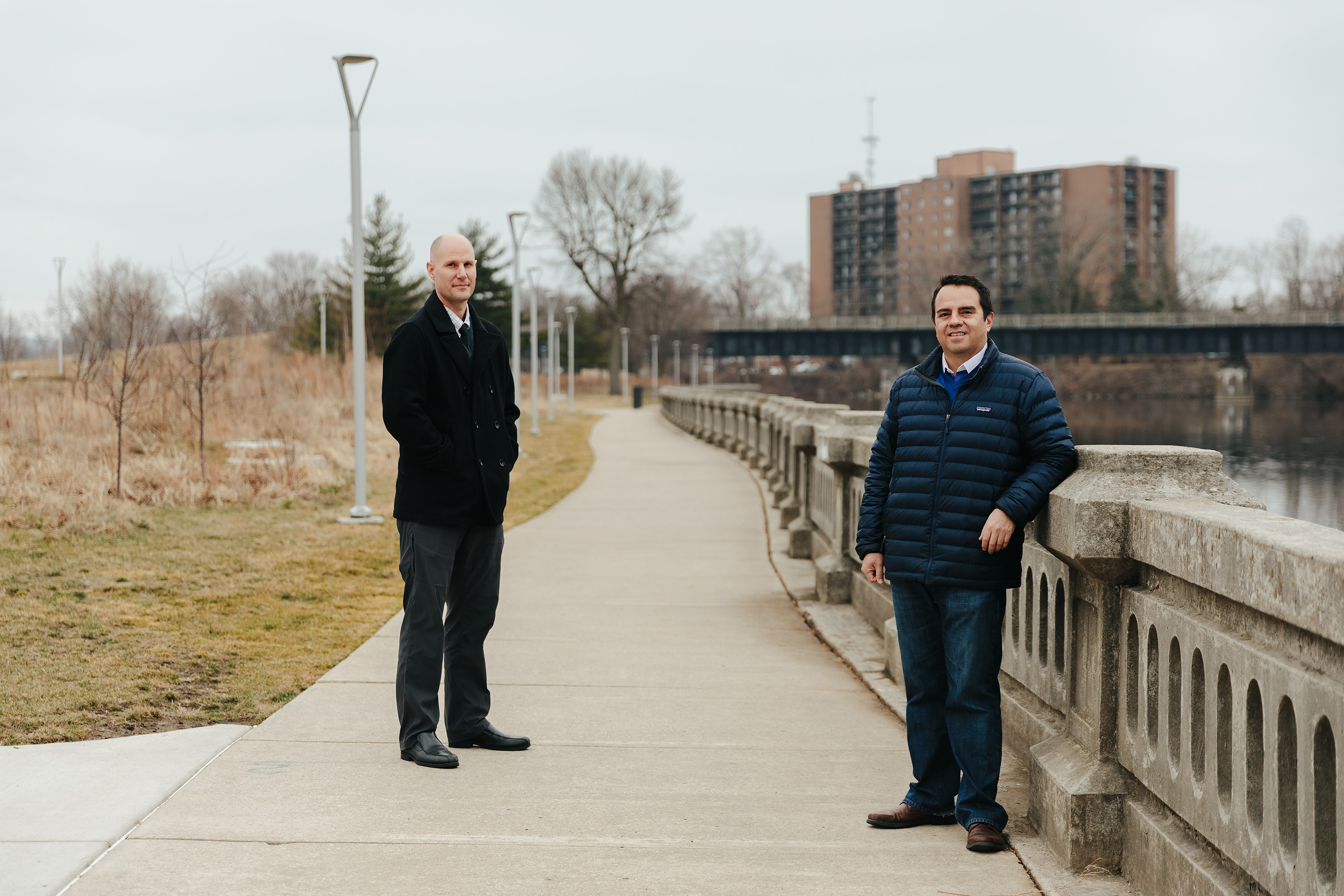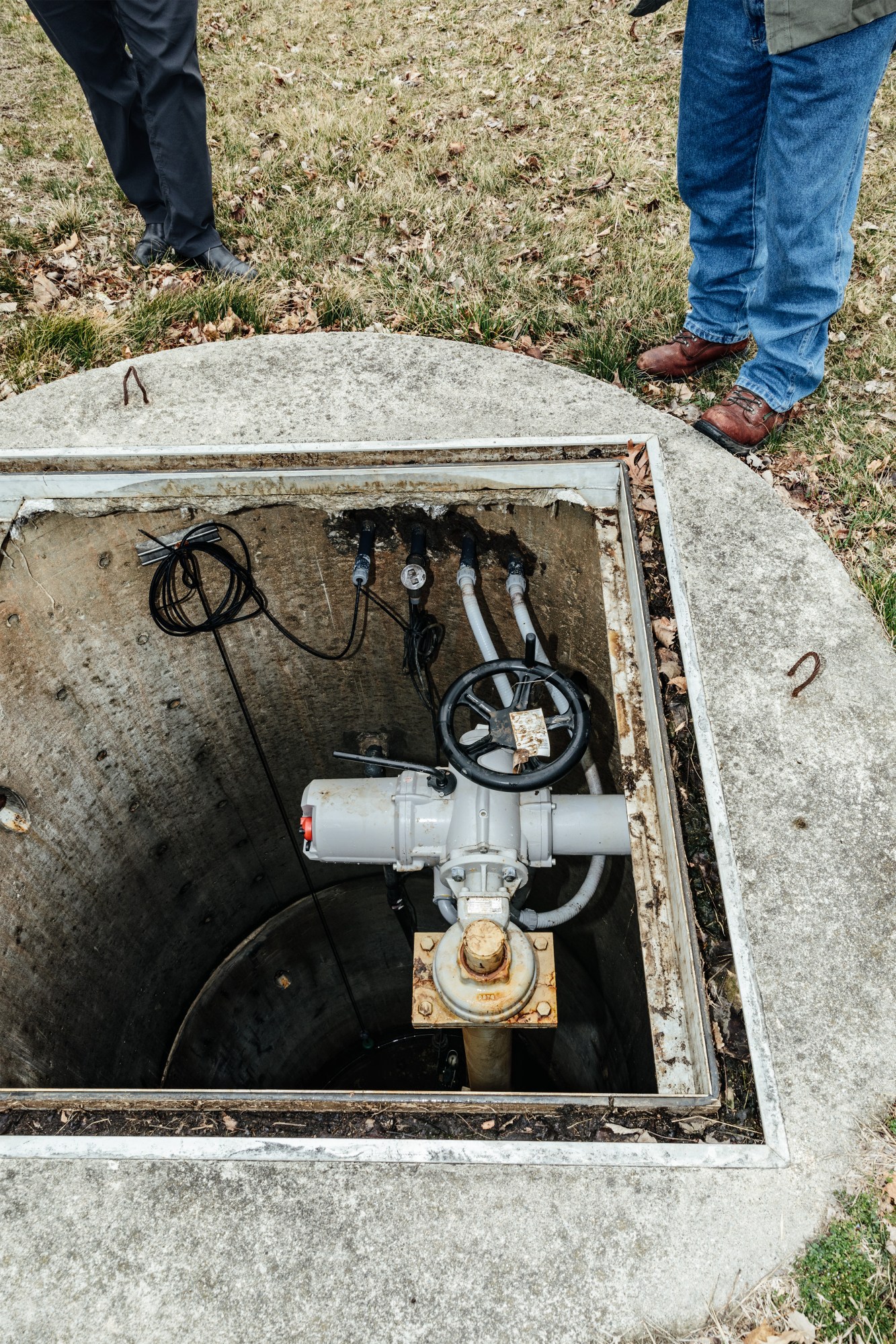One city’s fight to solve its sewage problem with sensors
America’s aging sewers need $1 trillion in repairs, but officials in South Bend, Indiana, have a plan to make them smarter.

In the city of South Bend, Indiana, wastewater from people’s kitchens, sinks, washing machines, and toilets flows through 35 neighborhood sewer lines. On good days, just before each line ends, a vertical throttle pipe diverts the sewage into an interceptor tube, which carries it to a treatment plant where solid pollutants and bacteria are filtered out.
As in many American cities, those pipes are combined with storm drains—hence the term “combined sewer,” a design that became popular as a cost-saving measure in the 1880s. So on bad days, when heavy rains or snowmelt overwhelms the capacity of the interceptor, the sewage goes straight into the St. Joseph River. This is bad for many reasons. Bacteria in fecal matter make rivers unsafe for swimming or boating. Antibiotic-resistant bacteria from hospital waste are released into the wild to multiply. Pharmaceuticals, pesticides, plastics, heavy metals, and hormones get into the ecosystem. Perhaps worst of all, the influx of nutrient-rich organic detritus can fuel the runaway growth of algae. This can fill rivers and lakes with toxic sludge, endangering wildlife and drinking water supplies.
In theory, the 1972 Clean Water Act prohibited cities (and other polluters) from sending their waste directly into rivers. But in practice, they kept on doing so. The Environmental Protection Agency estimates that between 23,000 and 75,000 such overflow incidents take place each year in the United States. They are also a major problem in Europe, where some 650,000 take place annually, most in older cities. Starting in the mid-1990s, the US Department of Justice sued cities including Atlanta, Los Angeles, Honolulu, Boston, Miami, Cincinnati, and Toledo on behalf of the EPA for violations of the Clean Water Act. It sought consent decrees—where local governments agree to binding terms to prevent tougher penalties—in many more municipalities.
Across America every year, combined sewers dump 850 billion gallons of raw sewage into waterways—about the same amount of water the Mississippi River annually carries into the Gulf of Mexico.
The EPA had warned the city of South Bend for years about its habitual pollution problem. In 2008, its worst year for storm and wastewater overflow so far this century, 2 billion gallons of untreated sewage flowed past the interceptor tube and into the St. Joseph River.
Finally, in 2011, three days before Pete Buttigieg took office as mayor, the agency forced South Bend into a consent decree, ultimately demanding $863 million worth of sewer upgrades. The bill added up, with financing, to about $10,000 per resident in a Rust Belt city where the median household income is under $40,000.
Two-thirds of America’s 800,000 miles of sewers are over 60 years old; restoring those pipes could cost more than $1 trillion.
South Bend’s story of overwhelmed infrastructure is, unfortunately, all too common. In the summer of 2011, about 250 miles to the east, a million acres of the surface of Lake Erie, the fourth-largest of the US and Canadian Great Lakes, had been covered in an algal bloom caused by combined-sewer overflows (along with agricultural and industrial runoff) from Toledo, Cleveland, and other cities. The New York Times reported “concentrations of microcystin, a liver toxin, [in the lake] that were 1,200 times World Health Organization limits, tainting the drinking water for 2.8 million consumers.”
Two-thirds of America’s 800,000 miles of sewers are over 60 years old; restoring those pipes could cost more than $1 trillion, according to the American Water Works Association. The American Society of Civil Engineers estimates that utilities spent $3 billion in 2019 replacing pipes, which was $81 billion less than the group figured they should have spent.

President Biden’s recently announced $2 trillion infrastructure plan could go some way toward alleviating the situation, if it becomes law. As currently written, the proposal includes $56 billion in grants and low-cost loans to state and local governments to “upgrade and modernize drinking water, wastewater, and stormwater systems.”
Once the money problem is addressed, though, there’s still the question of how exactly to go about making the upgrades. One way to eliminate overflows would be to separate the combined pipes by creating a whole new network of separate sewers and storm drains. (This is generally seen as prohibitively expensive.) Another option is to build new infrastructure to increase overflow capacity. That’s the approach being taken in London, where an enormous £4 billion ($5.5 billion) tunnel is being dug under the Thames River, intended to carry sewage from 34 points where it commonly overflows to a treatment plant 16 miles to the east, beginning in 2025.
Both those methods fall into the category of making bigger holes in which to put bigger pipes. For cash-strapped cities, that kind of expense is often out of reach. Such was the case in South Bend, which embarked on a third route: making its sewers smarter.
In 2008, the city began installing a network of devices that measured sewage depth and flow at dozens of points throughout its sewers. Then, in 2011, it implemented a real-time control system, with valves that automatically open and close in response to the sensor data. It wasn’t the first such system; Quebec City had put in a network in 1999. Copenhagen, Berlin, and Genoa, among other European cities, also began installing real-time monitoring and control systems in the late 1990s. But South Bend is among the pioneers.
“Most cities in the US have some aspect of control in their sewer system,” says Branko Kerkez, who researches smart-water systems as a professor of civil and environmental engineering at the University of Michigan. “South Bend became the poster child because they really operationalize it … they over-
instrumented [the sewer] so they could see how the whole thing changes in real time.”
Kieran Fahey, a tall and bearded Irishman, is in charge of the city’s sewage control plan. Before taking the job in 2015—he followed his wife, who had gotten a job at the University of Notre Dame—Fahey had worked for Ireland’s Environmental Protection Agency. He was the guy on the other side of the desk, telling communities what to do to conform with clean-water regulations. In South Bend, he has to figure out if there is a way to keep the city from going broke while complying with the EPA’s mandate.
“We’re trying to find the sweet spot,” he says. “Trying to not crucify the community economically, but also trying to make sure the river is taken care of as well.”
Since the sensors went in, the sewer overflow per inch of rain has dropped from 42.8 million gallons in 2008 to 6.9 million in 2020. If Fahey succeeds, those sensors might help cut overflows to zero.
South Bend’s sensor network is a descendant of control efforts dating back to the 1960s. The difference comes down to its sheer size and scope: it aims to control overflows over 600 miles of underground pipes.

Until the sensor network was put in place, a pair of city workers in South Bend used to drive around once a week, lift up manhole covers, and peer down, using nothing but their eyes to estimate how fast the sewage was flowing. If they saw gunk clogging a throttle line, they hoisted it out with a hook. During a storm, a city worker would have to drive across town to close an overflow valve. This worked, to an extent, for prolonged storms—but not for short, intense rains, which sometimes caused overflows before anyone could take action.
The shift to a more systematic, detailed, and faster system for gathering data took years. It was set in motion by Michael Lemmon, a professor at Notre Dame, whose campus sits at the city’s northern edge. In 2001, he got a grant from the Defense Advanced Research Projects Agency (DARPA) to see what could be done with credit-card-size, radio-enabled microcontrollers. After the September 11 attacks, the project was commandeered to see if small sensors could help find Al Qaeda fighters hiding in caves.
“I really was not very happy working on these military applications, even though it was important to do,” Lemmon says. “I was thinking about some other ways we could look at sensors.”
In 2003, Lemmon and a group of fellow engineers and researchers at Notre Dame realized they might be able to use them to do something about South Bend’s routine sewer overflows. In 2004, the research effort led to the formation of a company called EmNet. Luis Montestruque, an entrepreneurially minded electrical engineer who had worked with Lemmon on the DARPA project while finishing his doctorate, became the company’s president.
EmNet pitched its idea to Gary Gilot, then South Bend’s director of public works. Gilot is a soft-spoken, grandfatherly figure, perennially fascinated by new ideas. (As Fahey puts it: “If you said, ‘I want to measure every tree in South Bend because I feel like it’s able to help us with climate change,’ Gary would say, ‘Let’s go ahead and do it.’”)
Gilot was intrigued; peering down opened manholes in the middle of traffic to see if a sewer line is overflowing already seemed backward to him. In 2005, he gave EmNet a section of sewer along one city street as a test, to see if real-time monitoring of sewage flows could work.
There were problems from the outset. The environment in sewers is uninviting, to say the least. Excessive humidity weighs down the air. Sulfuric acid is always forming. Temperature swings are incessant and severe, as hot wastewater from showers and washing machines mixes with captured rainwater. Methane and hydrogen sulfide, both highly flammable and potentially explosive gases, are also constant hazards.
“The first device that we installed was this electronic board,” says Montestruque. “When we opened up the power box, it was gone—disintegrated. That’s how harsh the environment is.”
“When we opened up the power box, it was gone— disintegrated. That’s how harsh the environment is.”
Protecting electronic equipment became the challenge. Off-the-shelf devices to measure water flow and depth, which EmNet decided to use to lower its installation costs, were tough enough to withstand the conditions. But they’re susceptible to malfunction. Some sensors, in order to collect flow information based on pressure readings, have to hang in the sewage; they tend to be more accurate, but a wad of errant toilet paper could wrap around them, throwing off a reading.
Eventually EmNet set up what it calls nodes on the underside of manhole covers. Each node includes a sensor, a microprocessor, a radio, an antenna, and a lithium-ion battery. The sensors were exposed to rushing wastewater while the processor, radio, and battery were housed inside an explosion-proof box—both to protect against corrosion and to keep the electronics or the battery from igniting sewer gases. Attaching the nodes to manhole covers meant maintenance crews could access them easily.
On the strength of the data from the initial pilot section, Gilot gave the go-ahead to expand the system, paying EmNet $6 million to install sensors citywide. It officially went online in 2008, and EmNet continued installing nodes through 2010—150 in all. The sensors not only helped prevent overflows in the event of a storm but also served to detect obstructions in sewer lines that might otherwise have led to backups in residential basements.
Preventing a sewage overflow requires both resources and knowledge. Before the sensors came into use, the hydraulic models that administrators like Gilot used had to assume uniform rainfall across the whole city. But rain can be heavy on one side of South Bend and light on another—meaning that while some neighborhood sewer lines are brimming, others experience hardly any flow.
With the sensors in use, Gilot’s department was able to determine that placing nine new throttle pipes in neighborhood sewers could drastically reduce overflows. Starting in 2010, EmNet began outfitting these new pipes with microprocessor-equipped valves that automatically open and close in response to real-time calculations gauging the capacity of the interceptor line they feed into.

In times of heavy rainfall, the valves along sewers where the flow of stormwater and wastewater is high will automatically open; where flow is low, the valves remain closed. This creates more room in the interceptor pipe for the sewers that need it. In essence, Gilot and Montestruque had made the miles and miles of sewer pipes throughout the city into a makeshift storage tank: because the sewers with low flow aren’t at risk of overflowing, untreated water can sit in those lines—not flooding into the river, not backing up into people’s basements, and not hogging space at the treatment plant.
“We captured 23% more wet-weather flow just by using the same sewer system we had, but with smart monitoring and control technology,” Gilot says.
Load balancing is not always straightforward. If there is heavy rain in one part of a city but not another, the calculation might be relatively easy—but what should a system do when it’s raining everywhere? Even if the rain is concentrated in one area, it’s never certain whether the storm will move or stay in the same place. And of course, nobody wants a sewer pipe to burst from excessive pressure, especially in a populated area.
Montestruque’s solution was an agent-based model in which valves at overflow diversion points “buy” capacity from the interceptor tube. The interceptor tube’s diameter varies as it goes through the city, which complicates the task of figuring out its capacity for carrying waste to the treatment plant at any given moment. The market-based approach has the advantage of being computationally simpler than trying to fully model the complicated fluid dynamics throughout the sewer system.
Still, as Kerkez of the University of Michigan points out, a smart array of sensors and gauges can’t turn back the clock on an aging sewer system. “Everything has a breaking point,” he says. “What real-time control has the potential to do is push the boundaries of that breaking point out further. But there’s no fail-safe solution.”
Even with the improvements that Gilot had made, the sewers were still overflowing too often for the EPA’s liking—hence the 2011 consent decree. When Fahey arrived in South Bend, he inherited an optimized sewer system that was nonetheless pushing its limits.
To stop overflows, the EPA was asking the city to build seven underground tanks to store excess stormwater and wastewater. Many cities with combined-sewer systems use this approach. The tanks could hold up to 8.7 million gallons; once a big storm passes by, untreated water can be pumped from the tanks into the interceptor pipe and to the treatment plant. The tanks Fahey was contemplating were expensive. What’s more, their proposed locations were based on old stormwater models predicting where overflows were bound to happen. Two large, popular parks with mature trees would have to be sacrificed.
“The community was kind of up in arms with what was being proposed,” Fahey says. “It was just not feasible in South Bend. At the same time, we are putting sewage into the river, and that’s not really allowable either.”
One evening in 2016, Fahey met with Montestruque for beers at a local gastropub. Fahey was curious to see if the city could find ways to squeeze more gains out of its sensor-laden sewer system. The two of them realized that the same sensor data they had been using for real-time control of their existing sewer infrastructure could also help them plan for the future. “We said, ‘Listen, with all this data that we have, we should be able to come up with a hyperaccurate representation of how the system behaves,’” Montestruque recalls.

In designing a sewer system or planning for infrastructure upgrades, engineers use models and make certain assumptions. They calculate what they think might happen based on what-if scenarios governed by dozens of variables: the amount of rainfall in a year, for example, or the amount of water that will stay in the sewer system as opposed to overflowing into a river. But during the time the city has had a smart-sewer system, every kind of rainfall imaginable has fallen on South Bend. And because the sensors have been watching this happen all along, the city can look to the data to see how the sewers will react. “Instead of trying to predict what could happen, we’re able to say what did happen, and therefore what will happen again,” says Fahey.
“You’ll never solve a problem with just smart infrastructure."
It was a municipal-scale internet of things project. With EmNet’s help, Fahey parsed the sensor readings and found that the EPA plan calling for seven tanks at a cost of $863 million could be streamlined to a four-tank plan that would cost only $276 million. Part of the reason for the large difference in cost comes back to those models. In any sewer model, Fahey says, engineers will add a bit extra to account for a leaking tank, a cracking line, a once-in-a-century storm. Eventually, so much margin is added on that the final design is far more infrastructure-heavy than necessary. Sewer network designers widely anticipate that climate change is going to make their lives tougher by increasing the frequency of intense storms. The idea of using the data is to better understand just how storms tend to affect the flow of water through the complicated system of pipes in an urban network.
“The difference between the what-ifs and the what-did-happen is dollars. That’s the big thing,” Fahey says. “You’re able to save all those dollars by designing specifically to your needs, as opposed to what you think you might need.”
Over the last several years, the city of South Bend has been hashing out its new infrastructure proposal with officials at the EPA, who still need to give it federal approval. In addition to the four storage tanks, the plan also calls for green infrastructure, like rain gardens, and a promise to increase the capacity of the city’s wastewater treatment plant from its current 77 million gallons per day to 100 million gallons per day.
EmNet, meanwhile, is installing sensor systems in other cities. As of this year, it had projects under way in Grand Rapids, Michigan; Dayton, Ohio; and Buffalo, New York. Its biggest project so far, after its work in South Bend, involved implementing a similar system in Kansas City, Missouri, which was also feeling the strain of an EPA consent decree. Sewer lines in Kansas City are close to 160 years old, and the local government was struggling to prevent overflows into the Missouri River. Now Kansas City’s sewers are equipped with 300 sensors, which city managers expect will save the city about $1 billion in infrastructure costs. And, like South Bend, the city is now trying to renegotiate its deal with the EPA.

As populations grow, smart sensors can buy cities time until bigger pipes, bigger tubes, and bigger holes will be required. It’s not a perfect solution, of course. For one thing, introducing networked, real-time controls also means new vulnerabilities to software glitches and hacking. “You’ll never solve a problem with just smart infrastructure,” Fahey says.
Still, as Fahey walked the banks of the St. Joseph River last winter, snow crunching beneath his feet, a thought was ever present in his mind. In previous years on such a day, with light snow and some melting, a few thousand gallons of untreated sewage would spill into the river. It would have been easy to see from where Fahey stood. But on that afternoon, the river was calm. It looked clean. And the sewers below weren’t rushing at all.
Correction: This article originally said that the Notre Dame is near the southern boundary of the city of South Bend. It is, in fact, near the northern boundary. We regret the error.
Keep Reading
Most Popular
Large language models can do jaw-dropping things. But nobody knows exactly why.
And that's a problem. Figuring it out is one of the biggest scientific puzzles of our time and a crucial step towards controlling more powerful future models.
The problem with plug-in hybrids? Their drivers.
Plug-in hybrids are often sold as a transition to EVs, but new data from Europe shows we’re still underestimating the emissions they produce.
Google DeepMind’s new generative model makes Super Mario–like games from scratch
Genie learns how to control games by watching hours and hours of video. It could help train next-gen robots too.
How scientists traced a mysterious covid case back to six toilets
When wastewater surveillance turns into a hunt for a single infected individual, the ethics get tricky.
Stay connected
Get the latest updates from
MIT Technology Review
Discover special offers, top stories, upcoming events, and more.